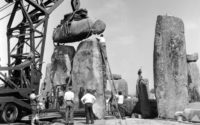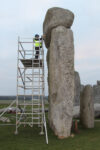 The core drilled out of one of Stonehenge’s sarsen stones in 1958 has answered one of the ancient site’s greatest mysteries: the source of its sarsen megaliths is West Woods in Wiltshire, 15 miles north of Salisbury Plain.
The core drilled out of one of Stonehenge’s sarsen stones in 1958 has answered one of the ancient site’s greatest mysteries: the source of its sarsen megaliths is West Woods in Wiltshire, 15 miles north of Salisbury Plain.
The smaller bluestones have been identified as coming from the Preseli Hills in southwest Wales and the Altar Stone (the central megalith in the circle) from the Senni Beds of east Wales 200 miles from the Salisbury Plain, but the origin of the massive sarsens has been debated by historians for four centuries. The prevailing theory since the 16th century is that they were transported from Marlborough Downs about 20 miles north of Stonehenge, mainly because that’s where you find the most and largest sarsens in Britain today.
Weighing an average of 20 metric tons and up to 23 feet high, the sarsens are so huge that moving them and installing them in the circle was an enormous undertaking in the 3rd millennium B.C. (or any time, for that matter). There were originally about 80 sarsen megaliths. Only 52 remain today, 15 of them in the iconic Trilithon Horseshoe. One of the trilithons in  the horseshoe, uprights 57 and 58 and lintel 158, had collapsed in 1797. In 1958, the Ministry of Works re-erected the trilithon. The uprights had longitudinal fractures, so to reinforce the cracked stones so they could bear the weight of the lintel, three holes an inch in diameter were drilled all the way through the meter-thick width of the stones 57 and 58 and metal ties inserted into the holes.
the horseshoe, uprights 57 and 58 and lintel 158, had collapsed in 1797. In 1958, the Ministry of Works re-erected the trilithon. The uprights had longitudinal fractures, so to reinforce the cracked stones so they could bear the weight of the lintel, three holes an inch in diameter were drilled all the way through the meter-thick width of the stones 57 and 58 and metal ties inserted into the holes.
The whereabouts of two of those cores are unknown. They were considered waste material at the time, and the one only survived because Roger Phillips, then employed with diamond cutting firm Van Moppes, kept it as a souvenir after he bored it out of Stone 58. After prizing it and carrying it with him across the world for decades, Phillips donated it to English Heritage in 2018.
 What was trash in 1958 is archaeological treasure today, and researchers immediately jumped on the opportunity to study the core, the sarsens in situ and sarsen boulders in the wild, so to speak. University of Brighton researchers scanned each of the 52 extant sarsens using non-invasive portable x-ray fluorescence spectrometry (PXRF) to determine their chemical composition. Inductively coupled plasma mass spectrometry (ICP-MS) and ICP–atomic emission spectrometry (ICP-AES) were then used to analyze the core from Stone 58 and a sampling of sarsen stones from 20 areas in southern Britain. By comparing the chemical signatures, researchers were able to determine the likely source of the sarsen stones at Stonehenge.
What was trash in 1958 is archaeological treasure today, and researchers immediately jumped on the opportunity to study the core, the sarsens in situ and sarsen boulders in the wild, so to speak. University of Brighton researchers scanned each of the 52 extant sarsens using non-invasive portable x-ray fluorescence spectrometry (PXRF) to determine their chemical composition. Inductively coupled plasma mass spectrometry (ICP-MS) and ICP–atomic emission spectrometry (ICP-AES) were then used to analyze the core from Stone 58 and a sampling of sarsen stones from 20 areas in southern Britain. By comparing the chemical signatures, researchers were able to determine the likely source of the sarsen stones at Stonehenge.
The meter-long core had to be cut in half lengthways, alas. English Heritage kept one of the half-cylinders. The others was cut into three samples for testing. The trace element signature comparison of Stone 58 with the sarsen boulder samples eliminated all but West Woods in southeast Marlborough Downs.
Overlooking the Kennet Valley to the north, West Woods covers a ~6-km2 area and comprises a plateau rising to 220 m above sea level that is dissected by two narrow valleys. The area once contained a dense concentration of sarsens, including a sarsen train mapped by the Ordnance Survey as recently as 1924. Most of the stones were broken up and removed from the mid-19th century onward. However, many large boulders remain, both in valleys and on high ground, and sarsen extraction pits are common, particularly in the northern woodland. West Woods lies within a concentration of Early Neolithic activity, being close to Avebury, numerous long barrows, and the causewayed enclosure at Knap Hill. Evidence of Mesolithic through Iron Age occupation has been recorded in the area, including a 40-m-long Early Neolithic chambered long barrow, sarsen standing stones, a sarsen polissoir used to sharpen stone axes, and prehistoric fields where now-wooded ground was previously open, cultivated land.
Why, in a region with the greatest density of extant sarsen stones in Britain, West Woods was selected as the primary source for the Stonehenge sarsens is unclear. Its significance most likely derives from the size and quality of the stones present there, making the area an important location for Neolithic people. Its topographic position on high ground south of the Kennet and its relative proximity to Salisbury Plain would also have made it an efficient place from which to obtain the sarsens. West Woods is located ~3 km south of the area where the majority of antiquaries and archaeologists have looked for Stonehenge’s sarsen quarries and, thus, lies slightly closer to the monument at ~25 km in a direct line.
The results of the study have been published in the journal Science Advances and can be read here.
I’m not one for picking someone up before they fall down and you’re far from lonely in this, but a metric tonne and an imperial ton are within a few pounds of one another. By way of mitigation I see that those in the US are more familiar with the short ton, which is 0.907 of a tonne. Did you ever get the feeling you shouldn’t have started? I just did!